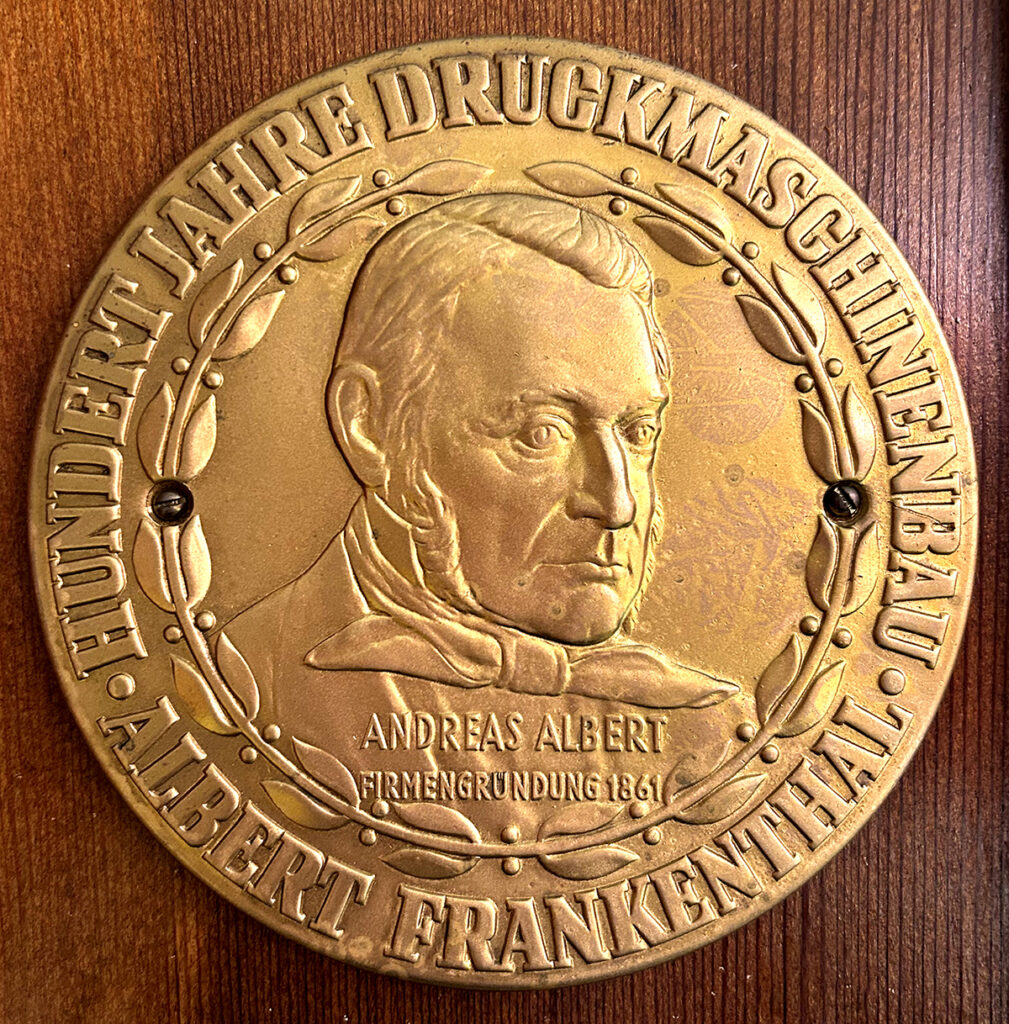
Features
Chronicle
Opinion
What’s in a name
From KBA to K&B
June 23, 2023 By Nick Howard
 This medallion was affixed to Albert presses during Albert’s centenary year of 1961. Photo courtesy Nick Howard
This medallion was affixed to Albert presses during Albert’s centenary year of 1961. Photo courtesy Nick Howard In 1817, Friedrich Koenig and his trusted partner Andreas Bauer started Koenig & Bauer (K & B) in the Bavarian town of Oberzell after returning from England.
While in England, the partners designed and constructed a breakthrough printing press for the Times of London newspaper. This cylinder printing press produced in one day what a battery of hand presses took weeks to do. This technology ushered in a dramatic change that vaulted K & B to a leadership position.
K & B never looked back and went about designing and building ever more complex web presses while expanding into other print areas, such as sheetfed cylinder presses, offset machines, and security presses. Today, it has a firm footing in digital printing systems.
The Oberzell facility also employed a young Andreas Albert, first, as an apprentice, and then master craftsman. Albert eventually left K & B to work for Reichenbach Mashinenfabrik, which was started by Koenig’s nephew and continues today as M.A.N. (Manroland).
In 1861, Albert joined forces with a cast iron foundry run by Andreas Hamm. Hamm’s firm has been in business, notably casting bells for churches, since 1850. Today, it is known as Heidelberger Druckmaschinen (Heidelberg). It wasn’t long before stop-cylinder presses left the picturesque German town of Frankenthal with both names emblazoned on the side frames.
Frankenthal’s domination
However, all was not well with the partners. By 1873, Albert terminated the partnership with Hamm and set up his company, Schnellpressenfabrik Albert & Cie. Soon there were new machines and radically improved technologies under the Albert name. In short order, web-fed presses were reaching customers all over Europe. K & B realized this young company was elbowing its way onto their home turf. As Albert grew more powerful, reaching over 1,200 employees and entering the gravure and offset business, the Frankenthal company became a threat to K & B and M.A.N.
In the 1920’s, Albert already had the world’s fastest web press, known as the “Red Devil.” By the early 1930s, Albert web presses with speeds of 30,000 revolutions were being installed in Europe. At that time, sheetfed letterpress business was dominant in Germany. But Albert held a whopping 60 per cent of the worldwide market of web presses, specifically rotogravure, by the late 1980s. Many web offset platforms designed by Albert during the 1970s and 1980s would become “Compacta” presses, a K & B trademark.
K & B decided to take action. In 1978, K & B orchestrated a purchase of 49 per cent of Albert from the owners, Rhineland Palatinate Ministry of Finance (local state government). In 1988, it increased its ownership to 74.99 per cent. When the 1990 unification of Germany brought about new opportunities, K & B purchased the final shares of Albert and, in so doing, launched the trade moniker, “KBA.”
This is how things remained until 2017 when KBA celebrated its 200th anniversary. K & B’s senior management marked the anniversary by adding an arsenal of press designs to its conglomerate. The brand, “KBA,” was also retired. Albert was relegated to the past. K & B was deemed to be the brand name of the world’s oldest printing press company.
The Albert purchase by K & B is one of the most monumental print-related acquisitions of the 20th century. Sadly, Albert’s role in shaping our industry is not widely known and only a few of us remember when the “A” in KBA stood for much more than just Albert.
Nick Howard, a partner in Howard Graphic Equipment and Howard Iron Works, is a printing historian, consultant, and Certified Appraiser of capital equipment. He can be reached at nick@howardgraphic.com.
This article originally appeared in the May/June 2023 issue of PrintAction.
Print this page